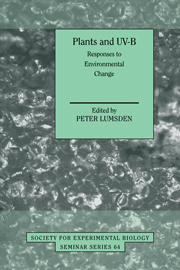Book contents
- Frontmatter
- Contents
- List of contributors
- Preface
- PART I The ozone layer and UV-B radiation
- PART II Effects of UV-B on plants at the cellular level
- DNA damage and repair in plants
- Genetic analysis of DNA repair in plants
- Photosynthesis and photoinhibition
- UV-B effects on the expression of genes encoding proteins involved in photosynthesis
- UV-B perception and signal transduction
- Ultraviolet radiation as a stress factor and the role of protective pigments
- PART III Effects of UV-B at the whole plant and community level
- Index
Genetic analysis of DNA repair in plants
Published online by Cambridge University Press: 04 August 2010
- Frontmatter
- Contents
- List of contributors
- Preface
- PART I The ozone layer and UV-B radiation
- PART II Effects of UV-B on plants at the cellular level
- DNA damage and repair in plants
- Genetic analysis of DNA repair in plants
- Photosynthesis and photoinhibition
- UV-B effects on the expression of genes encoding proteins involved in photosynthesis
- UV-B perception and signal transduction
- Ultraviolet radiation as a stress factor and the role of protective pigments
- PART III Effects of UV-B at the whole plant and community level
- Index
Summary
Introduction
Predicted increases in solar UV-B radiation have served to focus attention on the toxic effects of UV-B on plants. Nuclear DNA is present in very low copy number, and acts as the template for its own synthesis. For this reason, it is an especially vulnerable target for UV-induced damage. Even a single persisting UV-induced lesion can be a potentially lethal event, particularly in haploid tissues such as pollen grains.
The cyclobutane pyrimidine dimer (CPD) and the pyrimidine (6–4) pyrimidinone dimer (the 6–4 photoproduct) make up the great majority of UV-induced DNA damage products (Fig. 1) (Mitchell & Nairn, 1989). The biological effects of these lesions have been studied extensively in microbial and mammalian systems, where UV-induced DNA damage has been shown to produce two distinct effects: mutagenesis and toxicity. At the molecular level, pyrimidine dimers are known to inhibit the progress of microbial and mammalian DNA polymerases. Because pyrimidine dimers cannot effectively base pair with other nucleotides, they are not directly mutagenic, but instead act as blocks to DNA replication. Interestingly, and very significantly in terms of UV-induced toxicity, mammalian RNA polymerases have also been shown to ‘stall’ at both CPDs and 6–4 photoproducts (Protic-Sabljic & Kraemer, 1986; Mitchell, Vaughan & Nairn, 1989). Thus a single pyrimidine dimer, if left unrepaired, is sufficient to completely eliminate expression of a transcriptional unit.
- Type
- Chapter
- Information
- Plants and UV-BResponses to Environmental Change, pp. 77 - 94Publisher: Cambridge University PressPrint publication year: 1997
- 2
- Cited by



